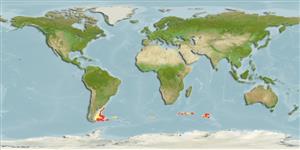Common names from other countries
Classification / Names / Names
Common names | Synonyms | Catalog of Fishes (gen., sp.) | ITIS | CoL | WoRMS
Malacostraca >
Decapoda (Lobster, shrimp and crabs) >
Lithodidae (stone and king crabs) > Lithodinae
Environment: milieu / climate zone / depth range / distribution range
Ecology
Benthic; depth range 120 - 1690 m (Ref. 3212). Temperate, preferred 1°C (Ref. 107945); 37°S - 60°S, 70°W - 71°E
Southern Oceans: Chile, South Georgia, Falkland Islands, Kerguelen Arc and the Antarctic Continental Shelf.
Length at first maturity / Size / Weight / Age
Maturity: Lm ? range ? - ? cm Max length : 11.0 cm CL male/unsexed; (Ref. 356); max. published weight: 559.00 g (Ref. 2690)
Maximum depth from Ref. 93860. Tends to concentrate in areas near the shelf break (Ref. 106921).
Life cycle and mating behavior
Maturity | Reproduction | Spawning | Eggs | Fecundity | Larvae
Members of the order Decapoda are mostly gonochoric. Mating behavior: Precopulatory courtship ritual is common (through olfactory and tactile cues); usually indirect sperm transfer.
SAUP Database. 2006. (Ref. 356)
IUCN Red List Status (Ref. 130435)
CITES status (Ref. 108899)
Not Evaluated
Not Evaluated
Human uses
Fisheries: commercial
FAO - Fisheries: landings | FIRMS (Stock assessments) | FishSource | Sea Around Us
Tools
Internet sources
Estimates based on models
Preferred temperature
(Ref.
115969): 1.4 - 4.7, mean 2.4 (based on 163 cells).
Vulnerability
Low vulnerability (10 of 100).
